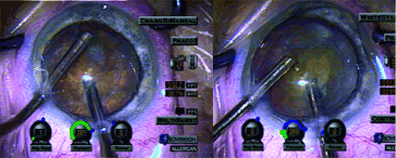| |
Device also
can boost vacuum for coaxial, surgeon
said. |
|
Surgeons that believe
bimanual microincision cataract surgery requires
lowering the vacuum levels for chamber stability
may find that's not necessarily true at the
upcoming ASCRSХASOA Symposium & Congress,
May 1-5, San Diego.
|
 |
|
High vacuum bimanual phaco chop using the
STAAR Surgical Cruise Control (Monrovia, Calif.)
and Chang horizontal irrigating
chopper.
Source: David Chang,
M.D.
|
|
|
|
|
| Bimanual microincision
cataract surgery can be performed using high
vacuum levels with STAAR Surgical's (Monrovia,
Calif.) Cruise Control device, said David F.
Chang, M.D., clinical professor of
ophthalmology, University of California, San
Francisco. Chang, who is scheduled to present
his findings, said that with Cruise Control, he
has performed bimanual phaco using a vacuum
level of 400 mm Hg on 50 consecutive patients
without compromising chamber
stability.
On Cruise Control
In contrast to standard
coaxial phaco, surge has been a major concern
when ophthalmologists perform bimanual
phacoemulsification, Chang said. Surge can occur
when there is an occlusion break from higher
vacuum levels, and fluid from the anterior
chamber rushes into the phacoemulsification tip
to equilibrate the lower pressure environment of
the aspiration line, he said.
The problem
with bimanual is that we don't get the same
amount infusion inflow that we do with the
coaxial irrigation sleeve,Ф Chang said. As a
result, if surgeons don't adjust their usual
vacuum parameters lower, they will see more
surge because of the decreased inflow
rate.Ф
Machine manufacturers have adopted
many strategies to reduce surge, including
stiffer-walled low compliance tubing, smart
pumps, and higher infusion sleeves.
But one
of the most effective strategies is to use a
flow restrictor,Ф Chang said. The disposable
Cruise Control device can be used with any
machine and is attached between the
phacoemulsification hand piece and aspiration
line. It has a 2-cm-long flow restrictor with a
0.3-mm diameter lumen, Chang said.
To
prevent this small opening from clogging, it's
situated behind a mesh filter that traps nuclear
particles, but allows fluid to percolate
through.
What I've found is that if we
combine Cruise Control with bimanual phaco,
we're able to go back to essentially the same
vacuum and flow rate settings that we use for
coaxial phaco,Ф Chang said. The Cruise Control
device nicely offsets the disadvantage of having
a lower infusion rate.Ф
Case results show
promise
For a series of 50
nuclei ranging in density from 2 to 3+, Chang
performed bimanual phaco using Cruise Control
with a 400 mm Hg vacuum setting and an
aspiration flow rate of 26 cc/min. Vacuum levels
were lowered to 200 mm Hg for the
epinucleus.
The cases went well and there
were no complications,Ф Chang said.
A
20-gauge beveled phacoemulsification tip and a
MST 20-gauge irrigating chopper (Microsurgical
Technology, Redmond, Wash.) were used with
Advanced Medical Optics' Sovereign, with
WhiteStar (Santa Ana, Calif.), and a standard
30-inch bottle height.
I had excellent
chamber stability and was able to perform
horizontal phaco chop with the strong holding
power normally afforded by higher vacuum
levels,Ф Chang said. So basically if I want to
go from coaxial phaco to bimanual phaco, all I
have to do is get out my 20-gauge irrigating
chopper and attach the Cruise Control to the
phaco hand piece and I can essentially use the
same settings that I employ for standard coaxial
phaco chop.Ф
Using the same equipment setup
without Cruise Control, Chang said that he
experiences too much surge when the vacuum
exceeds 250 mm Hg.
If I were to use 400 mm Hg
of vacuum without the Cruise Control device for
bimanual phaco in a similar series, I probably
would have torn a number of posterior capsules,Ф
he said
Cruise Control and coaxial
phaco
Cruise Control
was designed to allow ophthalmologists that
perform standard coaxial phaco to work at higher
vacuum levels, Chang said.
It should allow
surgeons to raise their vacuum levels by another
20% to 25% from their current settings,Ф he
said. Another situation in which surgeons need
extra surge suppression is the cataract with
weak zonules, he said.
A capsule that is
not taut will trampoline at vacuum levels that
are ordinarily very safe,Ф he said. Utilizing
Cruise Control in these cases is an alternative
to dropping the vacuum setting much lower to
prevent trampolining of a lax posterior
capsule.Ф
Editors'
note: Chang is a consultant for AMO. He
has no financial interests in STAAR Surgical or
in Microsurgical Technology.
Contact
Information
Chang: 650-948-9123, fax
650-948-0563, mailto:dceye@earthlink.net |